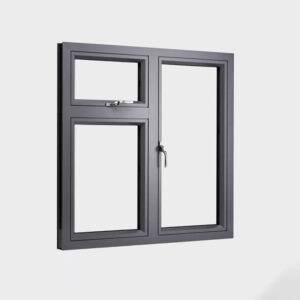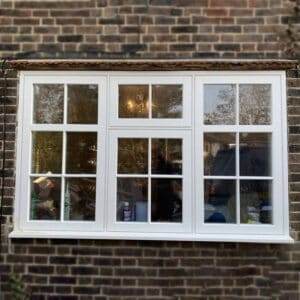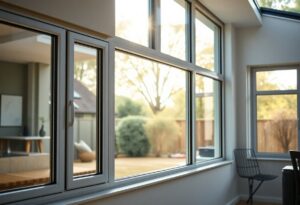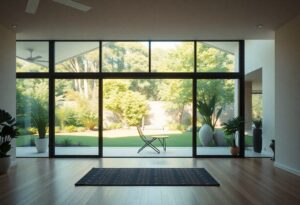With the increasing focus on energy efficiency, understanding the performance of your R2 windows and doors goes beyond just the U-Value. While this metric gives insight into thermal insulation, additional energy metrics can significantly impact your home’s energy consumption and comfort levels. In this article, you will discover various factors such as solar gain and air leakage, enabling you to make informed decisions that enhance both sustainability and your living environment.
Understanding U-Value
Before delving into the alternatives, it’s imperative to grasp the U-Value, a fundamental metric in assessing the thermal performance of windows and doors. This value measures the heat transfer rate, indicating how well a structure retains warmth. A lower U-Value signifies better insulation, making it a critical consideration in energy-efficient building practices.
Definition and Importance
Understanding the U-Value is vital as it provides you with a clear indication of your windows and doors’ thermal efficiency. By evaluating this metric, you can make informed choices that enhance your home’s energy efficiency, ultimately leading to reduced heating costs and improved comfort throughout the year.
Limitations of U-Value
Against its usefulness, the U-Value has notable limitations that you should consider. It solely measures heat transfer and does not account for other performance factors like solar gains or air leakage, which can significantly impact a building’s overall energy efficiency.
In addition, while the U-Value is valuable for comparing materials, it can be misleading if taken alone. Your windows and doors may exhibit an excellent U-Value but still present issues with air leakage, which can lead to increased energy consumption. Furthermore, the U-Value does not reflect the lifetime performance of the product, meaning that you could select an option that initially appears efficient but eventually fails to deliver in real-world conditions. This multifaceted nature of energy efficiency necessitates the evaluation of additional metrics, ensuring you make well-rounded decisions for your home’s energy performance.
Alternative Energy Metrics
The exploration of alternative energy metrics is significant in enhancing the overall efficiency of R2 windows and doors. By understanding these metrics, you can make informed choices that contribute to energy conservation and optimal comfort within your space. These metrics provide a broader perspective on energy performance, allowing you to evaluate the effectiveness of your installations beyond just the U-value.
Solar Heat Gain Coefficient (SHGC)
Metrics such as Solar Heat Gain Coefficient (SHGC) indicate how much solar radiation is admitted through your windows and doors, influencing indoor temperatures. A lower SHGC means less solar heat enters, which can reduce cooling costs during warmer months, whereas a higher value allows for passive solar heating in winter, potentially lowering heating expenses.
Air Leakage and its Implications
After considering SHGC, you should also assess air leakage, as it can significantly impact your home’s energy efficiency. It refers to the unintentional flow of air through joints and openings in your window and door installations.
Consequently, high levels of air leakage can lead to increased energy bills, as your heating and cooling systems work harder to maintain comfortable temperatures. Moreover, drafts may cause discomfort and negatively affect your indoor air quality. Addressing air leakage not only enhances energy efficiency but also improves your home’s overall comfort. Investing in well-sealed windows and doors ultimately protects your home from outside elements while reducing energy waste.

R-Value in Windows and Doors
One important metric to consider when evaluating windows and doors is the R-value, which measures the thermal resistance of a material. A higher R-value indicates better insulation properties, helping to prevent heat loss in winter and heat gain in summer. When you choose products with a high R-value, you enhance your property’s energy efficiency, leading to lower energy bills and a more comfortable living environment.
Relationship with U-Value
Around the topic of energy efficiency, it’s important to understand the relationship between R-value and U-value. While the R-value focuses on thermal resistance, the U-value measures how much heat is lost through a building element. They are inversely related; as the R-value increases, the U-value decreases. By assessing both values, you can make an informed decision regarding your windows and doors.
Assessing Overall Energy Efficiency
Below, when evaluating the overall energy efficiency of windows and doors, you should consider various factors, including their R-value and U-value, alongside elements such as air leakage, solar heat gain, and material quality. Each of these factors plays a significant role in your home’s energy performance. A comprehensive understanding will enable you to select the best options for your needs, maximising energy savings and comfort.
Doors and windows significantly influence your home’s energy efficiency. Opting for products with a high R-value coupled with low U-values will provide you with superior insulation. Additionally, pay attention to air leakage, as poorly fitted frames can undermine thermal performance. Selecting energy-efficient doors not only enhances your home’s comfort but can lead to a noticeable reduction in your energy costs, making your investment worthwhile in the long run.
Life Cycle Assessment (LCA)
After evaluating the performance of R2 windows and doors, it is vital to consider their Life Cycle Assessment (LCA), which assesses the environmental impacts throughout the product’s entire life span. This approach helps you understand not only the initial energy efficiency but also the long-term effects of materials and energy usage from manufacturing to disposal.
Environmental Impact of Materials
After assessing the materials used in R2 windows and doors, you will find that their environmental impact extends beyond energy consumption alone. Choosing sustainable materials reduces your carbon footprint and promotes better practices in construction and manufacturing.
Energy Consumption Over Time
The energy consumption of R2 windows and doors is an vital factor when considering their overall environmental impact. By focusing on how energy is used throughout their lifespan, you can make informed choices that not only benefit your home but also reduce your impact on the planet.
Understanding energy consumption over time is vital for maximising the benefits of your R2 windows and doors. By evaluating their operational efficiency, you can identify periods of high energy use and address potential issues. This ongoing assessment will help you make informed decisions about maintenance, upgrades, and even replacements. Ultimately, ensuring your windows and doors operate at peak performance can lead to significant cost savings and a reduced environmental footprint, enhancing your overall energy efficiency strategy.

Code Compliance and Certification
Now, ensuring that your R2 windows and doors meet the necessary code compliance and certification standards is necessary for both safety and energy efficiency. Adhering to these standards not only guarantees the longevity of your installations but also optimises their performance. This compliance can significantly impact your building’s energy ratings, which ultimately affects your overall costs and sustainability efforts.
Relevant Standards and Regulations
Around the industry, various standards and regulations govern the performance of windows and doors, with a particular focus on energy efficiency, thermal performance, and safety. Familiarising yourself with these requirements will help you make informed decisions that align with local building codes and enhance your property’s value.
Role of Testing Organizations
Along with compliance, testing organisations play a vital role in verifying the performance of R2 windows and doors through rigorous assessments. These organisations ensure that your installations meet the established standards for safety and energy efficiency, providing you with peace of mind.
Role of testing organisations extends beyond mere compliance; they are responsible for conducting independent, forensic assessments to validate the performance metrics of your windows and doors. They provide certifications that confirm adherence to necessary standards, helping you avoid potential liabilities and enhancing your project’s credibility. With their expertise, you can be confident that your installations not only fulfil local regulations but also excel in energy performance, ultimately leading to significant energy savings and a positive environmental impact.
Case Studies
Your understanding of energy performance will deepen through various case studies related to R2 windows and doors. These real-world examples illustrate how these products perform in different environments:
- Case Study 1: Residential Home in London – U-Value: 1.2 W/m²K, Energy Savings: 30%
- Case Study 2: Office Building in Manchester – U-Value: 1.1 W/m²K, Reduced Energy Costs: £500/month
- Case Study 3: School in Birmingham – U-Value: 0.9 W/m²K, Improved Student Comfort Rating: 20% Increase
High-Performance Windows and Doors
Windows and doors that focus on high performance boast significant improvements in energy efficiency. With advanced materials and technology, these installations can fulfil rigorous standards, leading to substantial reductions in heat loss and energy bills. By opting for high-performance options, you ultimately enhance the sustainability of your building.
Comparative Analysis of Metrics
Beside the U-Value, various other metrics can be used to assess the performance of your windows and doors. The following table highlights key energy metrics:
| Metric | Details |
|---|---|
| Solar Gain | Measured as g-value, indicating how much solar heat is gained |
| Thermal Bridging | Evaluates the impact of heat loss through building materials |
Indeed, understanding these metrics not only provides a more comprehensive view of performance but also allows you to make more informed decisions regarding your energy efficiency strategies. The significance of these detailed assessments can lead to long-term savings and improved comfort levels in your living or working environments. Each metric plays a vital role in constructing houses that are both energy-efficient and conducive to health.
| Important Metrics | Implications |
|---|---|
| Sound Insulation | Minimises external noise for better living conditions |
| Life Cycle Assessment | Assesses environmental impact over the product’s lifespan |
To wrap up
Hence, your understanding of energy metrics beyond the U-value is important for enhancing the efficiency and performance of R2 windows and doors. By considering additional factors such as solar heat gain and air leakage, you can make well-informed decisions that significantly improve your building’s energy profile. This comprehensive approach not only optimises thermal comfort but also aids in reducing energy consumption and costs over time. As you explore these metrics, you empower yourself to create more sustainable and energy-efficient living spaces.
FAQ
Q: What are R2 Windows & Doors, and how do they differ from standard options?
A: R2 Windows & Doors are specifically designed to enhance energy efficiency beyond traditional models. They incorporate advanced materials and construction techniques to improve insulation and reduce energy loss. Unlike standard windows and doors, which may primarily focus on U-values, R2 products also consider factors such as solar gain, air leakage, and thermal bridging to provide a more comprehensive energy efficiency solution.
Q: Why should I consider energy metrics beyond U-Value when evaluating windows and doors?
A: While U-Value is an important measure of thermal insulation, it does not account for all aspects of energy performance. Other metrics, such as solar heat gain coefficient (SHGC) and energy transmittance, play significant roles in assessing how much heat from the sun can enter a building and how efficiently windows and doors can manage indoor temperatures. Evaluating these additional metrics can lead to more informed decisions that optimise energy savings and comfort.
Q: How can R2 Windows & Doors contribute to reducing energy bills?
A: By employing innovative designs and high-quality materials, R2 Windows & Doors can significantly reduce the amount of energy needed for heating and cooling. Their enhanced thermal and airflow performance means that buildings can maintain comfortable temperatures with less reliance on heating systems, ultimately leading to lower energy consumption and reduced bills. When evaluated together with other metrics, the overall energy efficiency of the building increases.
Q: Are R2 Windows & Doors suitable for all types of buildings?
A: Yes, R2 Windows & Doors can be adapted to various building types, including residential, commercial, and industrial properties. Their energy-efficient features can benefit any structure, whether it is a new build or a renovation project. It is necessary to assess the specific energy needs and architectural characteristics of the building to ensure optimal performance.
Q: What is the long-term impact of investing in R2 Windows & Doors?
A: Investing in R2 Windows & Doors not only leads to immediate energy savings but also offers long-term benefits, such as increased property value and improved comfort levels. Over time, the reduction in energy usage can provide a substantial return on investment. Additionally, by opting for energy-efficient solutions, homeowners and businesses contribute to a reduction in carbon footprint, promoting sustainability and environmental responsibility.













